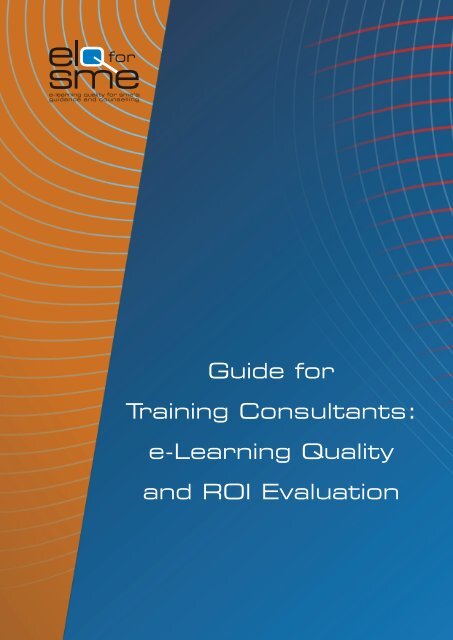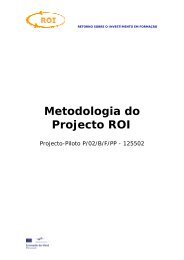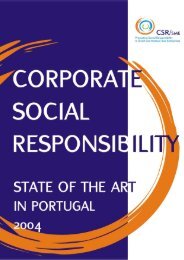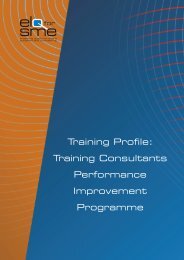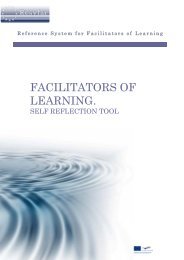Guide for Training Consultants: e-Learning Quality and ROI ... - Cecoa
Guide for Training Consultants: e-Learning Quality and ROI ... - Cecoa
Guide for Training Consultants: e-Learning Quality and ROI ... - Cecoa
- No tags were found...
You also want an ePaper? Increase the reach of your titles
YUMPU automatically turns print PDFs into web optimized ePapers that Google loves.
GUIDE FOR TRAININGCONSULTANTS:e-<strong>Learning</strong> <strong>Quality</strong> <strong>and</strong><strong>ROI</strong> EvaluationEdited by© ELQ-SMEs Project
© ELQ-SMEs Project 20071st editionPublisher: University of Tartu, Distance Education CentreUlikooli 18 50090 Tartu, EstoniaTelephone: +372 737 63 06Fax: +372 732 55 62E-mail: Lehti.Pilt@ut.eeHomepage: http://www.ut.eeOther contacts:Partnership contact: elq-sme@lists.ut.eePromoter contact: estudos@cecoa.ptProject Homepage: http://www.nettskolen.com/in_english/elq-sme/Copyright © ELQ-SMEs Project: CECOA (PT), BFI Berufsförderungs – InstitutSteiermark (AT), F-BB Forschungsinstitut Bertriebliche (DE), University of Tartu -Distance Education Centre (EE), Confederació de Comerç de Catalunya (ES), Profitwise(NL) <strong>and</strong> NKI Distance Education (NO). All rights reserved.No part of this publication may be reproduced, stored in a retrieval system, ortransmitted, in any <strong>for</strong>m or by any means, electronic, mechanical, photocopying,recording, or otherwise, without the prior written permission of CECOA (ProjectPromoter).2E-<strong>Learning</strong> <strong>Quality</strong> <strong>for</strong> SME's: Guidance <strong>and</strong> Counselling
Title<strong>Guide</strong> <strong>for</strong> <strong>Training</strong> <strong>Consultants</strong>: e-<strong>Learning</strong> <strong>Quality</strong> <strong>and</strong> <strong>ROI</strong> EvaluationEditionELQ-SMEs Project 2007Project CoordinationV<strong>and</strong>a Vieira, CECOA, PortugalAuthorsDiederick Stoel, ProfitWise, Netherl<strong>and</strong>sRene van Leeuwen, ProfitWise, Netherl<strong>and</strong>sPartners ValidationIsabel Rucabado, CCC, SpainJavier Coll, CCC, SpainJörg Spath, BFI, AustriaLehti Pilt, University of Tartu, EstoniaMorten F. Paulsen, NKI, NorwayNatalie Morawietz, F-BB, GermanyNiels-Christian Moe, NKI, NorwayTriin Mar<strong>and</strong>i, University of Tartu, EstoniaV<strong>and</strong>a Vieira, CECOA, PortugalPlace of EditionTartu, EstoniaDate of EditionNovember, 2007Number of Copies150E-<strong>Learning</strong> <strong>Quality</strong> <strong>for</strong> SME's: Guidance <strong>and</strong> Counselling3
Contents1. Introduction .................................................................................................................. 51.1. What is e-learning? ................................................................................................. 51.2. Rationale ................................................................................................................. 72. What is <strong>ROI</strong>, why <strong>ROI</strong> <strong>and</strong> how do you calculate <strong>ROI</strong>?............................................ 72.1. What is <strong>ROI</strong>? ........................................................................................................... 72.2. Why <strong>ROI</strong>?................................................................................................................ 82.3. How do you calculate <strong>ROI</strong>?..................................................................................... 83. Economic chain ......................................................................................................... 103.1. Chain ..................................................................................................................... 103.2. Actors .................................................................................................................... 103.3. Cash flows within a chain ...................................................................................... 113.4. Cash flows outside a chain.................................................................................... 114. Method ........................................................................................................................ 124.1. Financial <strong>and</strong> economic chain............................................................................... 12An example................................................................................................................... 14Flour wholesaler ........................................................................................................... 14Baker (introduction) ...................................................................................................... 15Health care institution................................................................................................... 15Baker (cont.)................................................................................................................. 15The Baker’s income...................................................................................................... 16The Baker’s expenditure .............................................................................................. 16Business training provider ............................................................................................ 17Method:......................................................................................................................... 19Another example .......................................................................................................... 205. Conclusions................................................................................................................ 226. Partnership contacts ................................................................................................. 234E-<strong>Learning</strong> <strong>Quality</strong> <strong>for</strong> SME's: Guidance <strong>and</strong> Counselling
1. IntroductionThe <strong>Guide</strong> <strong>for</strong> <strong>Training</strong> <strong>Consultants</strong>: E-<strong>Learning</strong> <strong>Quality</strong> <strong>and</strong> <strong>ROI</strong> Evaluation was developedunder the Pilot Project ELQ-SMEs - e-<strong>Learning</strong> <strong>Quality</strong> <strong>for</strong> SMEs: Guidance <strong>and</strong> Counselling,supported by the Leonardo da Vinci Programme.This guide is targeted to training consultants <strong>and</strong> Vocational <strong>Training</strong> Centres. CECOA wasresponsible <strong>for</strong> the technical coordination of the <strong>Guide</strong> <strong>for</strong> <strong>Training</strong> <strong>Consultants</strong>: E-<strong>Learning</strong><strong>Quality</strong> <strong>and</strong> <strong>ROI</strong> Evaluation. ProfitWise was responsible <strong>for</strong> the internal evaluation of theproduct <strong>and</strong> provided also the contents, case demonstration <strong>and</strong> support.The partnership is fully aware that this <strong>Guide</strong> <strong>for</strong> <strong>Training</strong> <strong>Consultants</strong> is not a complete work.It must be seen just as a “step <strong>for</strong>ward” in the attempt to guidance <strong>and</strong> orientation to thetraining consultants during their contact with the SMEs.We hope that this product result will help training consultants, training coordinators, trainers<strong>and</strong> e-learning providers to demonstrate the added-value of e-learning <strong>for</strong> SMEs <strong>and</strong> toguiding employers to settle e-learning solutions at sectorial level. Assuming this project asthe beginning of a continuous improvement process, the partnership welcomes allcontributions, suggestions <strong>and</strong> comments that end-users would like to <strong>for</strong>ward.1.1. What is e-learning?The difference between e-learning <strong>and</strong> a good e-learning depends on the application of acouple of basic rules.It requires a ‘back to basic’ approach. One has to think about the major learning goalsthat have to be reached. One does have to let go of the traditional ways of learning. Onehas to look to the type of organisation that one is working <strong>for</strong>.More concrete it will lead to a set of basic rules that one has to keep in mind whendeveloping e-learning.Those rules are:E-<strong>Learning</strong> <strong>Quality</strong> <strong>for</strong> SME's: Guidance <strong>and</strong> Counselling5
Type of organisation:An organisation can be directive managed: this will lead to a instructive e-learning. It alsoleads to an e-learning that can reach to insight learning goals.An organisation that is project driven requires an e-learning that will give h<strong>and</strong> vesselswithin the playing field of the organisation. So you can next to reproductive learning goalsalso reach reproductive skills.An organisation that is let bottom up requires an e-learning that will offer space tolearning goals that come up to productive learning goals. And <strong>for</strong> the total collaborativeorganisation we can develop an e-e-learning that comes up to productive skills. In thiscase we are talking about a parallel reality. In the last two cases we are talking aboutonline interactive. Think about sales challenges <strong>and</strong> the parallel reality. In this kind ofenvironments people are improving their knowledge <strong>and</strong> skills as it is in reality. Thelearning effect will be higher than in the first two cases.When we start developing e-learning we have keep in mind that learning from a monitorrequires a lot of different aspects than learning in a classroom.For instance we have to make sure that people stay connected to the content. How toget people connected to their monitor?There<strong>for</strong>e we have developed 10 triggers <strong>and</strong> 5 conditions:Triggers to keep people connected to their monitor:1. Control;2. Eye catcher;3. Surprise;4. Score;5. Practical;6. Alternatives;7. Recognizable;8. Enrichment;9. Eye opener;10. Confronting.Conditions <strong>for</strong> <strong>for</strong>mat <strong>and</strong> content:1. Diversity;2. Short;3. Clear;4. Visual;5. Oversight.6E-<strong>Learning</strong> <strong>Quality</strong> <strong>for</strong> SME's: Guidance <strong>and</strong> Counselling
If one is able to create an e-learning with those items in mind, people will stay connectedto their monitor <strong>and</strong> will the effect of the e-learning at least reached the effects of antraditional training. So the choice <strong>for</strong> an e-learning is not only a financial choice but firstof all the possibility to reached the determined learning goals in a more effective waythan via traditional training a development.There<strong>for</strong>e the presented method of calculating the <strong>ROI</strong> of an e-learning leads to thecomparison of investments vs. benefits. An alternative is also presented but thiscompares the costs of traditional vs. e-learning.1.2. RationaleAs an SME consultant you work <strong>for</strong> a target group which is responsible <strong>for</strong> 80% of allbusiness. It is likely that you also regularly wonder how many opportunities are availableto this target group, which have not yet been capitalised on. In a word, you are still facedwith extensive undeveloped territory. In this document we will show you how you c<strong>and</strong>evelop part of this undeveloped territory. Here we are referring to the field of education<strong>and</strong> training with the focus on e-learning in particular.We are convinced that SME’s do not invest in e-learning, because they feel that theadded value offered by this type of education has not yet been adequately revealed.Consequently, this is where you have work to do! One of the most common methods ofshowing that investing in education is worthwhile is by comparing income <strong>and</strong>expenditure in a clearly defined manner. Calculating <strong>ROI</strong>, or return on investment, is aclassical method which is used <strong>for</strong> this purpose.With the aid of this document, we are providing you with tips which you can use tocalculate <strong>ROI</strong>. We have broken this document down into two parts. First of all, we showyou how to per<strong>for</strong>m a single <strong>ROI</strong> calculation. Because you have to contend with variousstakeholders who all have their own interests, in the second part we show you how toper<strong>for</strong>m a multi-pronged <strong>ROI</strong> calculation. It is precisely in this respect that this documentdiffers from traditional views of <strong>ROI</strong>.2. What is <strong>ROI</strong>, why <strong>ROI</strong> <strong>and</strong> how doyou calculate <strong>ROI</strong>?2.1. What is <strong>ROI</strong>?Return on investment is the yield of an investment in relation to the costs involved in itexpressed as a percentage. In view of the fact that <strong>ROI</strong> does not necessarily involvemoney, a percentage is calculated. For example, expenditure can also be measured interms of time. In this case, <strong>for</strong> example, we refer to the time required to break even.However, we can often see that it is practical to express units in terms of money in orderE-<strong>Learning</strong> <strong>Quality</strong> <strong>for</strong> SME's: Guidance <strong>and</strong> Counselling7
to state added value in the <strong>for</strong>m of a <strong>ROI</strong> percentage in this way, <strong>and</strong> to facilitatecomparison.2.2. Why <strong>ROI</strong>?<strong>ROI</strong> is an aid to which decision-makers respond. The decision-makers often base theirdecisions on the feeling that they have, when they receive proposals. This feeling is oftenlargely determined by a proposal’s financial impact. It is there<strong>for</strong>e preferable to calculate<strong>ROI</strong> in terms of money.2.3. How do you calculate <strong>ROI</strong>?To put it briefly, <strong>ROI</strong> is income less expenditure divided by expenditure multiplied by100%!Put another way, how much added value does an investment generate in relation to thefinancial sacrifice that must be made in order to secure it? When calculating <strong>ROI</strong> it isthere<strong>for</strong>e vitally important to present as comprehensive a breakdown of the expenditure<strong>and</strong> attributable income as possible. In order to do this factors are mentioned, which areexpressed as financial figures. In this respect you may wish to consider, <strong>for</strong> example, thevalue of additional sales after one has completed training, the marketing costs involvedin the launch of a product when it is developed, or what costs are occasioned by delaywhere staff cannot make any sales while they are attending training. Alternatively, thereis the cost of lost opportunities or the income which is generated thanks to the fact that,after staff have attended training, they are capable of working more effectively <strong>and</strong>/ormore efficiently (operational excellence).Example:A company hires a representative to sell its products to its customers. Thisrepresentative costs the company €100,000.00 in the <strong>for</strong>m of an annual salary. In orderto work this representative requires a car. The investment in this car, including allrelevant expenses (fuel, insurance, <strong>and</strong> the purchase <strong>and</strong> depreciation of the vehicle),amounts to €50,000.00.As such, the total expenditure amounts to €150,000.00.If this representative succeeds in achieving sales worth €200,000.00, his <strong>ROI</strong> will amountto the following:{[(income): €200,000.00 less (expenditure): €150,000.00] divided by (expenditure)€150,000.00} x 100% = 33.3%8E-<strong>Learning</strong> <strong>Quality</strong> <strong>for</strong> SME's: Guidance <strong>and</strong> Counselling
In other words, <strong>for</strong> every euro which it invests, the company receives €1.33.As you can see, <strong>ROI</strong> has everything to do with an economic chain. After all, investmentsare made <strong>and</strong> goods are sold to others. We will focus on this economic chain in the nextsection.E-<strong>Learning</strong> <strong>Quality</strong> <strong>for</strong> SME's: Guidance <strong>and</strong> Counselling9
3. Economic chainAs a consultant <strong>for</strong> SMEs working in the public <strong>and</strong> private sector, you are part of aneconomical system. You are doing business with other parties (actors). You have to dealwith customers, suppliers <strong>and</strong> other shareholders. You are part of a market, your market!This market is part of a larger economical system (local, nationwide, European or evenworldwide). As you look to your business in this perspective you will see that it isimportant to deliver value to your business environment. In this chapter we will tell yousomething about this economical system so you can better underst<strong>and</strong> the way you canadvise <strong>and</strong> help your customers.ActorsSMEshareholdersMarket / ROWCashflow (ROW – shareholders – SME – shareholders - ROW)3.1. ChainIf one examines a macro-economic chain, what it amounts to – to put it briefly – is that aneconomy is a circuit into which money enters <strong>and</strong>, after various actors have added valueto it (be it in return <strong>for</strong> payment or not), it then leaves the chain again. This chainthere<strong>for</strong>e actually consists of a number of layers or shells enveloping each other. Theselayers or shells are <strong>for</strong>med by a micro-economic chain (<strong>for</strong> example, within a company),a meso-economic chain (within a collaborative relationship) <strong>and</strong> a macro-economic chain(the meso-economy plus an indeterminate array of actors who are also known as the restof the world).3.2. ActorsActors are organisations or people who add value to a product or service. These actorsoften operate as part of a customer-supplier relationship. Naturally, it is possible that theactivities which an actor adds, cannot be directly attributed to a product or service but dogenerate expenses (investments are dem<strong>and</strong>ed). In this respect, you may wish to10E-<strong>Learning</strong> <strong>Quality</strong> <strong>for</strong> SME's: Guidance <strong>and</strong> Counselling
consider the allocation of the cost of HR services to that of a specific type of potatopeeler which a household goods company sells. For example, consider the manner inwhich your customers assign your services to their products.3.3. Cash flows within a chainWithin a chain cash flows are based on the ability to bear costs. Someone accepts thecost of delivery (the cost-bearer). Every addition to a product or service is charged to thenext actor. The cost of an advertising campaign is included in the relevant product’sselling price.3.4. Cash flows outside a chainUltimately, expenditure is charged to an indeterminate number of actors (<strong>for</strong> example,consumers in the retail trade) or is included in an unspecified product (the potato peelermentioned above). In this way the money leaves the chain <strong>and</strong> the financial impact of therelevant investment is shared in a product which cannot be accounted <strong>for</strong> in greaterdetail. As such, the money leaves the meso-economic chain <strong>and</strong> goes on to become partof the macro-economic chain. In this respect, you can imagine that, <strong>for</strong> example, asupplier of photocopying paper is able to calculate the cost of his production process <strong>and</strong>to invoice his customers accordingly (Actor 1 invoices Actor 2). It is then almostimpossible <strong>for</strong> Actor 2 to specify the added value incorporated in the use of thephotocopying paper in his product. Consequently, the precise item of expenditurebecomes part of a larger component of generic expenses <strong>and</strong> is charged on to anunspecified number of customers as part of a larger entity (the money leaves the chain<strong>and</strong> ‘disappears’ amongst the rest of the world).In view of the fact that we now know how <strong>ROI</strong> is calculated <strong>and</strong> the manner in whichcash flows constitute part of the overall economic chain, we will be able to focuspredominantly on the method used to associate cash flows <strong>and</strong> <strong>ROI</strong> with each other inthe next section.E-<strong>Learning</strong> <strong>Quality</strong> <strong>for</strong> SME's: Guidance <strong>and</strong> Counselling11
4. Method4.1. Financial <strong>and</strong> economic chainIn the meantime we have determined that <strong>ROI</strong> is actually the ratio of investments to theincome which can be attributed to these investments. This gives rise to the question asto whose investments <strong>and</strong> income this refers to.What we are actually concerned with here is whether a consultant can answer thisquestion <strong>for</strong> the following three parties:1. His client;2. His client’s customers;3. And ultimately himself!Assuming that income <strong>for</strong> one party simultaneously represents expenditure to another,this gives rise to the following matrix.The income <strong>for</strong> each actor is filled in along the horizontal axis. The expenditure of eachactor is entered along the vertical axis. Eventually, the total costs of each actor are filledin at the end on the right, while their overall income is entered right at the bottom.IncomeRestActor 1 Actor 2 Actor nof theworldtotalActor 1ExpenditureActor 2Actor nRestof theworldtotal<strong>ROI</strong> Actor 1 =income -/-expenditureX 100%expenditure12E-<strong>Learning</strong> <strong>Quality</strong> <strong>for</strong> SME's: Guidance <strong>and</strong> Counselling
ExpenditureIncomeTotalTotalIncome - Expenditure<strong>ROI</strong> of Actor 1ExpenditureIf we take the data from the first example <strong>and</strong> enter it into the table below, this producesthe following.incomex Organisation ROW(carrepresentative)dealer,TotalExpenditureOrganisation x 150,000 150,000ROW200,000 x 200,000(sales tocustomers)Total 200,000 150,000 xThe following is evident:- The organisation’s income amounts to €200,000.00;- The company’s expenditure amounts to €150,000.00.Expressed as a <strong>for</strong>mula: [(€200,000.00 – €150,000.00) / €150,000.00] x 100% = 33.3%.If we extrapolate this example further, we could, <strong>for</strong> example, also calculate what theorganisation’s customers gain. If the representative in this example were able to showE-<strong>Learning</strong> <strong>Quality</strong> <strong>for</strong> SME's: Guidance <strong>and</strong> Counselling13
what gains his customers could offer their customers, they may be more inclined topurchase goods from him.At the start of this document we noted that SMEs do not fully appreciate the value of e-learning, <strong>for</strong> example. A cycle is created in this manner. Any customer, who can seewhat benefit your advice would have <strong>for</strong> him <strong>and</strong> <strong>for</strong> his customers, would be moreinclined to invest in good advice <strong>and</strong> development: your advice!We refer to this as a multi-pronged <strong>ROI</strong> calculation. Such a calculation is provided ingreater detail in the following example.An exampleThis example makes use of a situation which has occurred in the Netherl<strong>and</strong>s. A bakerengaged the services of a consultant to resolve a problem which had occurred in hisbusiness. Matters have been simplified in order to ensure that this example is clear.However, this simplification does not in any way affect the return calculated in thisexample. The current situation is that, based on the advice provided by the consultant,the baker in this example now has three highly profitable retail outlets coupled withbakeries, <strong>and</strong> currently supplies bread to five health care institutions. No names arementioned in this case study <strong>for</strong> reasons relating to privacy.We will be calculating the <strong>ROI</strong> <strong>for</strong> the various actors based on a description of thesituation.We will reveal the <strong>ROI</strong> <strong>for</strong> the following parties in consecutive order:• A flour supplier;• A baker;• A health care institution;• A business training provider.A baker buys flour from a wholesaler, uses it to bake bread <strong>and</strong> sells his bread to ahealth care institution <strong>for</strong> senior citizens (an old-age home), amongst other things.Flour wholesalerAs a result of poor harvests a flour wholesaler raises his prices <strong>for</strong> the supply of flour to abaker. The flour supplier’s return on his supplies remains constant as a result. Once theprice of flour falls to its current level again next year because there will have been anormal harvest, the flour supplier will then be able to drop his prices, so as to ensure thathis return (<strong>ROI</strong>) remains constant. His <strong>ROI</strong> consequently remains constant <strong>and</strong> mayincrease in the future.14E-<strong>Learning</strong> <strong>Quality</strong> <strong>for</strong> SME's: Guidance <strong>and</strong> Counselling
Baker (introduction)The baker is unable to pass on the price increase that has been announced, to his endcustomer (the health care institution), otherwise he will lose his supply contract. Thehealth care institution’s primary concern is that its clients feel fine. Healthy nutrition is animportant factor in this respect.The baker purchases flour from the wholesaler <strong>for</strong> a price of €500.00 <strong>and</strong> adds valueamounting to €250.00 to the flour (processing, time, electricity <strong>and</strong> transport). Every daythe baker supplies the health care institution with bread valued at €1000.00.The baker’s <strong>ROI</strong> amounts to 33.33% ([(€1000.00 - €750.00) / €750.00] x 100%).As a result of poor harvests suffered by its suppliers the flour plant’s price increaseamounts to €100.00.As a result the baker’s <strong>ROI</strong> amounts to 17.64% ([(€1000.00 - €850.00) / €850.00] x100%).Apparently there has been a decrease of 15.69%!The baker now has a choice. Either he accepts a 45% (from 33.33% to 17.64%) drop inhis return or he looks <strong>for</strong> a way to ensure that his <strong>ROI</strong> remains at a higher level withouthis end customer experiencing any inconvenience as a result.Health care institutionThe baker comes up with the idea that it is actually much better <strong>for</strong> elderly people to eatbread which is not too fresh. This would have a positive impact on their digestive system,which works more slowly, with the result that these people would feel better. Ifconsumers feel better thanks to his bread, then than the health care institution would beproviding greater added value through its services! An increase in the added value ofthese services would mean a rise in the number of its clients. This would in turn elicitmore in the way of government subsidies. As long as it is possible <strong>for</strong> the health careinstitution to exp<strong>and</strong> within the bounds of its capacity, this would not push up its fixedexpenses, with the result that it would be possible to provide more <strong>and</strong> better care withonly a limited increase in its expenditure (after all, only its variable costs would rise). Thiswould have a positive impact on the health care institution’s <strong>ROI</strong>: greater satisfactionamongst its clients <strong>and</strong> more in the way of subsidies to ensure the provision of evenbetter care.Baker (cont.)The health care institution has given the baker an undertaking that his three-yearcontract will be renewed <strong>for</strong> a further period of three years, if he succeeds in partlyE-<strong>Learning</strong> <strong>Quality</strong> <strong>for</strong> SME's: Guidance <strong>and</strong> Counselling15
ensuring that the health care institution’s customers feel better. He believes that it will bea simple matter to do this by supplying bread which is only one day old.The baker wishes to substantiate this with facts <strong>and</strong> funds a medical study (research)into the digestive system of the human body. The cost of this study amounts to€6,000.00. At the same time the baker thinks that he will no longer be inconvenienced inthe <strong>for</strong>m of a loss due to an incorrect estimate on his part of his daily sales. He will takethe excess of his normal production on one day <strong>and</strong> supply it to the health care institutionon the following day. As a result his loss (approximately 10% of his daily turnover of€1500.00) will be reduced to 0%.If we now examine the baker’s <strong>ROI</strong>, we see the following.The Baker’s incomeNormal income from his supplies: €1000.00.Additional income thanks to a reduction of his loss on the excess: €150.00 (because hisloss on this excess amounting to 10% of €1500.00 has been reduced to 0% of the latter).The Baker’s expenditureResearch subsidy€6,000.00 spread over a period of three years (five deliveries per week over a period ofthree years amounts to 780 deliveries – 5 x 52 x 3 – per annum). This represents aninvestment in additional expenditure of €7.70 (€6,000.00 / 780).Production costsThe cost of production amounts to €850.00 per delivery.As such, the baker’s <strong>ROI</strong> amounts to the following:[(€1150.00 - €857.70)] / €857.70 x 100% = 34.07%The baker’s <strong>ROI</strong> has risen from 33.33% to 34.07% as a result of an investment inknowledge <strong>and</strong> in spite of an increase in expenditure.Suppose that flour prices recover <strong>and</strong> drop to their current lower level, because nextyear’s harvest is as it was in the past. In this case his <strong>ROI</strong> would rise by a further17.71%. After all:[(€1150.00 - €757.70)] / €757.70 x 100% =51.78% (compared with 34.07%, thisrepresents an increase of 17.71%).16E-<strong>Learning</strong> <strong>Quality</strong> <strong>for</strong> SME's: Guidance <strong>and</strong> Counselling
Business training providerSuppose that the baker <strong>and</strong> then also receives sound business training from hisprofessional association, as a result of which he is able to procure supplies at keenerprices (<strong>for</strong> example, procurement savings of only 2%). Taken over a period of threeyears (780 deliveries) this would amount to €9,360.00 (€600.00 x 2% x 780). An averageprocurement course currently costs approximately €5,000.00. The baker’s investment inthis course produces a <strong>ROI</strong> <strong>for</strong> him of 87.2% ([(€9,360.00 – €5,000.00)] / €5,000.00 x100%).Suppose that this business training provider decides to offer the course in electronic<strong>for</strong>m. What would his <strong>ROI</strong> be in this case?The development of a procurement course in electronic <strong>for</strong>m requires an investment of€250,000.00. It is anticipated that he will have approximately 2000 trainees (spread overvarious target groups). This is because a procurement course is a <strong>for</strong>m of generictraining which can offer added value to the entire SME sector. Suppose that theprofessional association offers the course <strong>for</strong> €500.00. (This represents 10% of the costsinvolved. After all, attending such a course costs €5,000.00). As such, the provider’sincome amounts to €1,000,000.00 (€500.00 x 2000). This means that the traininginstitute’s <strong>ROI</strong> amounts to 300% ([(€1,000,000.00 – €250,000.00) / €250,000.00] x100%)!If all of the data taken over a period of three years (which is 780 deliveries five times aweek over 52 weeks per annum over three years – 5 x 52 x 3 = 780) is inserted in atable, the latter will be as follows.E-<strong>Learning</strong> <strong>Quality</strong> <strong>for</strong> SME's: Guidance <strong>and</strong> Counselling17
INCOMEx Flour Plant Baker Old-age Home <strong>Training</strong> Centre ROW TotalFlour plant x 9,360 1 - - NA NABaker 468,000 2 x - 5,000 3 195,000 46,000 5 674,000(669,000+5,000)EXPENDITUREOld-age home - 780,000 6 x - - 780,000<strong>Training</strong> centre - - - x 250,000 7 250,000ROW - 117,000 8 780,000 9 995,000 10 x 1,896,500Total 468,000 906,360(897,000+9,360)780,000 1,000,000 451,000 xSavings achieved through procurement at keener prices:savings of 1% x €600.00 (purchase price per delivery) x 780 deliveries = €9,360.00Total value of the deliveries made by the flour plant to the baker:€600.00 x 780 = €468,000.00Cost of procuring a course <strong>for</strong> SMEs: €5.000.00The baker adds €250.00 to the product in the case of each delivery multiplied by 780deliveries = €195,000.One-off investment in research into the human digestive system amounting to €6,000.00.18E-<strong>Learning</strong> <strong>Quality</strong> <strong>for</strong> SME's: Guidance <strong>and</strong> Counselling
780 deliveries to the old-age home of €1,000 = €780,000.00.Investment in the development of a course on ‘effective procurement’.A gain of 10% x €1,500.00 x 780 deliveries = €117,000.00 on the baker’s normal dailyturnover, because he is now able to deliver bread that is one day old, to the old-agehome. This is a conservative estimate, because the baker makes an average of sixdeliveries a week (Mondays to Saturdays), while the calculation is based on fivedeliveries per week.This refers to the cost of the bread which the old-age home accounts <strong>for</strong> as food in itsbudgets.This refers to income from 199 courses (the baker procures one) <strong>for</strong> a fee of €5,000.00(199 x €5,000 = €995,000.00).Baker’s <strong>ROI</strong> on deliveries to the old-age home:[(€897,000 – €669,000) / €669,000] x 100% = 34.08%Baker’s <strong>ROI</strong> on the procurement of the course he attends:[(€8,950,50 – €5,000) / €5,000] x 100% = 79.01%<strong>Training</strong> centre’s <strong>ROI</strong>:[(€1,000,000 – €250,000) / €250,000] x 100% = 300%Method:• Identify the actors within the relevant chain (clients, contractors, customers);• Specify the earnings of the various actors <strong>and</strong> identify those actors <strong>for</strong> whom theyrepresent expenditure;• Develop the model until you reach the rest of the world (ROW);• Total the income <strong>and</strong> expenditure;• Calculate the <strong>ROI</strong> in accordance with the <strong>for</strong>mula, [(income –expenditure)/expenditure] * 100%;• Present the outcome <strong>for</strong> each actor.In this way it is possible to calculate a multi-pronged <strong>ROI</strong>: one <strong>for</strong> a client (<strong>for</strong> example, afinancier), one <strong>for</strong> a contractor <strong>and</strong> one <strong>for</strong> a customer.E-<strong>Learning</strong> <strong>Quality</strong> <strong>for</strong> SME's: Guidance <strong>and</strong> Counselling19
Another exampleA commercial provider of products wants to train his sales department. There are 30people working on the sales department as account manager. Their task is to sell theproducts.The entrepreneur feels the need to train his people on their competences.According to CEDEFOP Glossary a competence is the ability to apply knowledge, knowhow<strong>and</strong> skills in a habitual <strong>and</strong>/or changing work situation.For a traditional program is needed:• A docent <strong>for</strong> knowledge (3 days);• A trainer <strong>for</strong> skills (3 days);• A business coach <strong>for</strong> expression <strong>and</strong> culture (3 days);• A personal coach <strong>for</strong> motivation (3 days).After running the program there has to be attention <strong>for</strong> transfer because programs oftenrun in a short time. We have to be careful that the skills can grow to natural behaviour.Let’s look at this case in a financial way:The cost <strong>for</strong> running this program will be 12 days (€ 1500, a day) x € 1500 = € 18.000.People are 12 days unproductive. The labor cost per hour is about € 50. For 12 days thismeans 12 x 8 x € 50 = € 4800.So the cost per program will be about € 22.800,We did not count the cost <strong>for</strong> accommodation, loss of sales, etc. Because there are 30account managers working in this company, we have to run the program three times.The total cost <strong>for</strong> this program is 3 x € 22.800 = € 68.400If we offer this program in a digital <strong>for</strong>m the cost <strong>for</strong> a flat e-learning that coversknowledge <strong>and</strong> skills, we have to pay € 40.000. For a sales challenge based onindividuals we have to invest € 20.000. These investments are based on the averageprice of e-learning applications that develop the knowledge <strong>and</strong> skills of an individual.The total costs will be € 60.000.20E-<strong>Learning</strong> <strong>Quality</strong> <strong>for</strong> SME's: Guidance <strong>and</strong> Counselling
Let’s look from an educational point of viewIn the traditional way we are doing role plays. One or two participants can do a role playa time. The others are watching. People can learn from watching but learn more fromdoing.The average time of a role play is about 30 minutes. The effective time during a trainingday is about 6 hours. This means that we can do 12 role plays a day. In three days wecan do at most 30 role plays, because of explanation of sales theory, etc. That means 3active role plays per person. To be more precise, 1,5 times in a role as account manager<strong>and</strong> 1,5 times in the role of customer. Often we see that the feedback from the otherparticipants is subjective. People know each other, didn’t watch very good.During a sales challenge each person does 20 role plays in his role as account manager.The participant receives personal objective feedback (based on specific organizationalsubjects <strong>and</strong> matters) from the system <strong>and</strong> can share his experiences with other peopleby P2P development reports.Let’s be careful <strong>and</strong> say that the effectiveness of a traditional trainer is twice theeffectiveness of a digital solution. This means that a digital solution is still more than300% more effective. In a calculation: 3 time’s personal attention during a traditional roleplay x 2 = 6 times personal attention in a traditional way. 20 times during a digital saleschallenge.[20/6] x 100% = 333%!Let’s look at this case from a logistic point of viewWhen the company hires a new employee on the sales department, this person has towait till there are 10 new persons be<strong>for</strong>e they can start a new program. If the companychooses <strong>for</strong> a digital solution the newly hired can start with his educational program atany time. So this person is earlier ready to per<strong>for</strong>m in his role as an account manager.It is also a fact that individual digital solution is presented “just in time” <strong>and</strong> due to a goodassessment “just enough”. So the effective study time will reduce with about 75%.This isnext to the fact that it shows that people prefer to study on Sunday <strong>and</strong> Thursdayevening (in their own time). So the company does not have the loss of labor <strong>for</strong>ce duringworking time.ConclusionChoosing <strong>for</strong> a digital solution is much cheaper <strong>and</strong> far more effective <strong>for</strong> anorganization, than choosing <strong>for</strong> a traditional way of education. But the proof is still ineating the pudding. Are you hungry?E-<strong>Learning</strong> <strong>Quality</strong> <strong>for</strong> SME's: Guidance <strong>and</strong> Counselling21
5. ConclusionsBy clarifying what gains can be achieved <strong>and</strong> where this can occur, the threshold islowered <strong>for</strong> SMEs to go along with the development of e-learning. In this case theexample provided the following:• An <strong>ROI</strong> <strong>for</strong> the flour plant (not worked out in concrete figures, because none areavailable);• A multi-pronged <strong>ROI</strong> <strong>for</strong> the baker (relating to his deliveries <strong>and</strong> training);• An <strong>ROI</strong> <strong>for</strong> the health care institution (not in the <strong>for</strong>m of figures but based on itsmission – providing the best possible service to its clients);• An <strong>ROI</strong> <strong>for</strong> the training centre (this could simply be the education department of aprofessional association).All in all, this represents precisely the type of calculation of multiple <strong>ROI</strong>s <strong>and</strong> a multipronged<strong>ROI</strong>, which should enable consultants to explain solutions to their interlocutorsin a qualitative manner.When you are able adding value to your customers you can improve your <strong>ROI</strong>. In factyou are creating a win-win-win situation. You are able to show your value to yourcustomers (which will affect your <strong>ROI</strong> positive) by helping to show their value to theirmarket (which will affect their <strong>ROI</strong> positive) <strong>and</strong> so on.In addition, it is precisely the benefits that are offered together with the educationalpreferences of a rejuvenating target group, which offer ample opportunities to generatemore income frequently coupled with reduced expenditure (this need not even be thecase in some situations, as the example reveals) <strong>and</strong> to achieve greater staffsatisfaction, because a better response is produced to accommodate the educationalrequirements of the most important productive factor to be found in a business: itshuman capital.In this method we have chosen to calculate the <strong>ROI</strong> as a comparison between theinvestment that had to be made <strong>and</strong> the benefits that one receives. It is also possible tocalculate the <strong>ROI</strong> in a comparison between the costs <strong>and</strong> benefits <strong>for</strong> an traditionalcourse <strong>and</strong> the costs <strong>and</strong> benefits <strong>for</strong> an e-learning course. However, the choice <strong>for</strong> e-learning does not only depend on the financial outcome of a calculation. In some cases itis not possible to train people on a traditional way due to a timeframe or because oflogistic problems (when people work on different places <strong>and</strong> it is not possible to cometogether on a collective time <strong>and</strong> date.22E-<strong>Learning</strong> <strong>Quality</strong> <strong>for</strong> SME's: Guidance <strong>and</strong> Counselling
6. Partnership contactsCECOA – Centro de Formação Profissional para o Comércio e AfinsRua da Sociedade Farmacêutica, nº 31169-074 LisbonTel: ++ 351 213112400Fax: ++ 351 213112424E-mail: v<strong>and</strong>a.vieira@cecoa.ptContact Person: V<strong>and</strong>a Vieirawww.cecoa.ptBFIMariengasse, 248020 GrazTel: ++ 4331672761Fax: ++ 4331672753E-mail: joerg.spath@bfi-stmk.atContact Person: Jörg Spathwww.bfi-stmk.atUniversity of Tartu, Open University CentreUlikooli, 1850090 TartuTel: ++ 372 737 63 06Fax: ++ 372 732 55 62E-mail: Lehti.pilt@ut.eeContact Person: Lehti Piltwww.ut.eeProfitWiseWG Plein 1891054SC AmsterdamTel: ++ 31 20 412 1392Fax: ++ 31 20 412 1406E-mail: roi@profitwise.infoContact Person: Diederick Stoelwww.profitwise.infoF-BB, Research Institute <strong>for</strong> In-House<strong>Training</strong>Obere Turnstr, 890429 NurnbergTel: ++ 49 911 277 79 22Fax: ++ 49 911 277 79 50E-mail: morawietz.natalie@f-bb.deContact Person: Morawietz Nataliewww.f-bb.deConfederació de Comerç de CalalunyaVia Layetana, 32, 2 ND, 50-52 Offi08003 BarcelonaTel: ++ 93 491 06 06Fax: ++ 93 491 25 16E-mail: ccc@confecomercat.esContact Person: Javier Collwww.confecomercat.esNKI Distance EducationHans Burums vei 30,PO Box 111,1319 BekkestuaTel: ++ 47 67588800Fax: ++ 47 67530500E-mail: morten@nettskolen.comContact Person: Morten Flate Paulsenwww.nettskolen.comE-<strong>Learning</strong> <strong>Quality</strong> <strong>for</strong> SME's: Guidance <strong>and</strong> Counselling23
Promoter: CECOA – Centro de Formação Profissionalpara o Comércio e Afins (Portugal) www.cecoa.ptBFI (Berufsförderungsinstitut) Steiermark (Austria)www.bfi-stmk.atForschungsinstitut Betriebliche Bildung (f-bb) gGmbH (Germany)www.f-bb.deUniversity of Tartu, Open University Centre (Estonia)www.ut.eeConfederació de Comerç de Calalunya (Spain)www.confecomercat.esProfitWise (Netherl<strong>and</strong>s)www.profitwise.infoNKI Distance Education (Norway)www.nki.noEducation <strong>and</strong> CulturePilot projectsThis project has been funded with support from European Commission. Thispublication reflects the views only of the author, <strong>and</strong> the Commission cannot beheld responsible <strong>for</strong> any use which may be made of the in<strong>for</strong>mation containedtherein.


